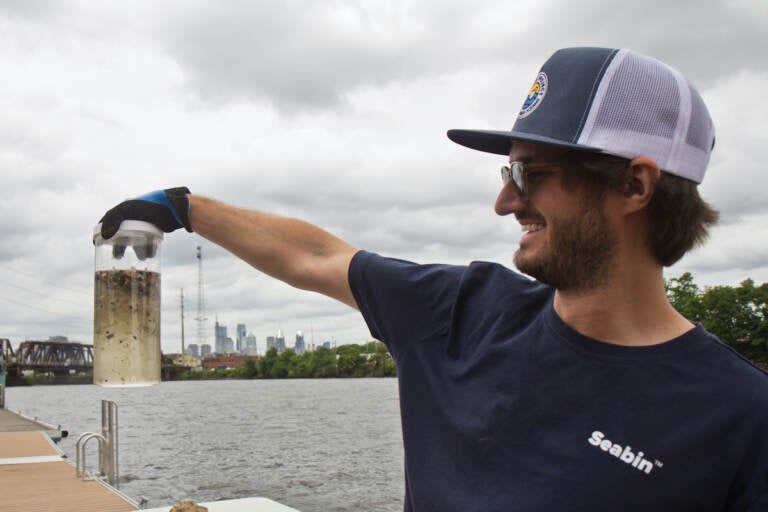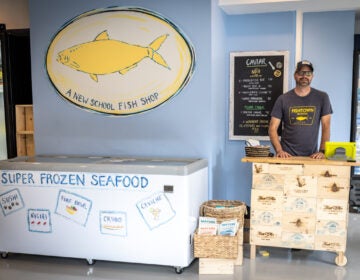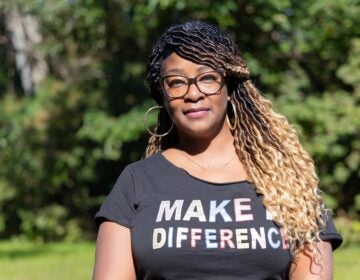Could these simple ‘Seabins’ give us better information about the plastics hiding in Philly’s rivers?
The “Seabin” trash capture devices will help the EPA, along with the Partnership for the Delaware Estuary, to gather important data on what types of plastics are in the water.
Listen 1:53
Hayden Gould, Executive Project Manager, Seabin North America, holds up a container of micro plastics collected out of the Delaware River Watershed at a demonstration of their trash collecting devices at Bartrams’ Gardens on June 7, 2022. (Kimberly Paynter/WHYY)
At Bartram’s Gardens floating dock in Southwest Philadelphia, a simple looking trash can was lowered into the Schuylkill River on Tuesday afternoon.
This one was different from what you see lining the sidewalks on trash day. While it looks similar, inside is a yellow mesh filter. A pump at the bottom sucks all of the surrounding water, including sticks, leaves, and lots of plastic bottles.

It’s all part of a new project to pilot a simple technology created by the Australian company Seabin. The trash capture devices — also called “Seabins” — will help the U.S. Environmental Protection Agency (EPA), along with the Partnership for the Delaware Estuary, to gather important data on what types of plastics are in the Delaware and Schuylkill Rivers.
“So, you could think of this as plastics forensics, litter forensics,” said Adam Ortiz, EPA administrator for the Mid-Atlantic region.

Ortiz says the goal of the project is to understand where the plastics come from, how they get there, and what types dominate the rivers.
The collections began in May and will include eight “Seabins” in separate locations in both Philadelphia and Camden. So far, the company’s aquatic trash cans have filtered 15.2 million gallons of water that contained 890 pounds of plastic. The majority were “microplastics” — a whopping 58,000 pieces. These kinds of plastics, often missed by the human eye, are defined as fragments that are smaller than 5 mm in length.

Ortiz says he hopes the information collected during the project will help inform the public on how to prevent pollution. But, he adds, the EPA and individuals are not the only responsible parties.
“We need to work on the systems level with manufacturers and others so the stuff that’s entering our disposable steam is as sustainable as possible,” he said.
During Tuesday’s demonstration on the river, collection bins full of yellow caution tape and plastic bottles were mixed with tiny pieces of plastics and styrofoam — a smattering of what took about 15 minutes to collect in the bin.
“The amount of small pieces of plastic was unbelievable,” said Kathy Klein, executive director of the Partnership for the Delaware Estuary. “I mean, you don’t see it when you’re watching the water flow by you on the river, you see the bigger things like water bottles, but the amount of small pieces was really overwhelming.”

The EPA contributed a $25,000 grant toward the project, which will train high school students to sort and count the pieces of plastic this summer.
Plastic water bottles make up half of all trash floating in Philadelphia’s rivers and streams, according to the Philadelphia Water Department. The city has its own “skimmers” that trawl the Schuylkill and Delaware Rivers, collecting 1.1 tons of plastics each year. The city’s combined sewer and stormwater system means that runoff leads to litter on street corners, often ending up in the wastewater treatment system, as well as spilling into rivers and streams during heavy rain events.
WHYY is your source for fact-based, in-depth journalism and information. As a nonprofit organization, we rely on financial support from readers like you. Please give today.








